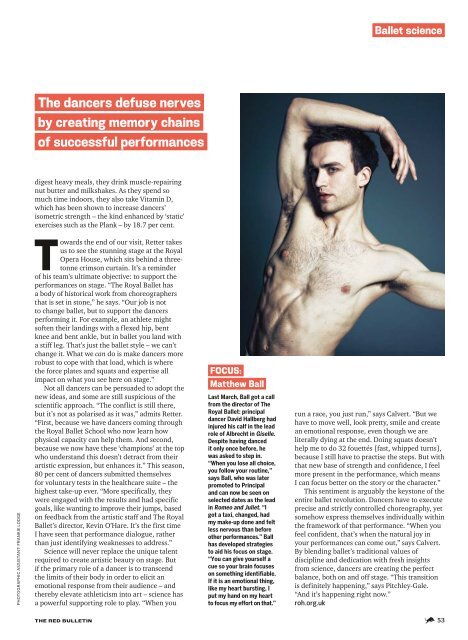You also want an ePaper? Increase the reach of your titles
YUMPU automatically turns print PDFs into web optimized ePapers that Google loves.
Ballet science<br />
<strong>The</strong> dancers defuse nerves<br />
by creating memory chains<br />
of successful performances<br />
digest heavy meals, they drink muscle-repairing<br />
nut butter and milkshakes. As they spend so<br />
much time indoors, they also take Vitamin D,<br />
which has been shown to increase dancers’<br />
isometric strength – the kind enhanced by ‘static’<br />
exercises such as the Plank – by 18.7 per cent.<br />
PHOTOGRAPHIC ASSISTANT: FRANKIE LODGE<br />
Towards the end of our visit, Retter takes<br />
us to see the stunning stage at the Royal<br />
Opera House, which sits behind a threetonne<br />
crimson curtain. It’s a reminder<br />
of his team’s ultimate objective: to support the<br />
performances on stage. “<strong>The</strong> Royal Ballet has<br />
a body of historical work from choreographers<br />
that is set in stone,” he says. “Our job is not<br />
to change ballet, but to support the dancers<br />
performing it. For example, an athlete might<br />
soften their landings with a flexed hip, bent<br />
knee and bent ankle, but in ballet you land with<br />
a stiff leg. That’s just the ballet style – we can’t<br />
change it. What we can do is make dancers more<br />
robust to cope with that load, which is where<br />
the force plates and squats and expertise all<br />
impact on what you see here on stage.”<br />
Not all dancers can be persuaded to adopt the<br />
new ideas, and some are still suspicious of the<br />
scientific approach. “<strong>The</strong> conflict is still there,<br />
but it’s not as polarised as it was,” admits Retter.<br />
“First, because we have dancers coming through<br />
the Royal Ballet School who now learn how<br />
physical capacity can help them. And second,<br />
because we now have these ‘champions’ at the top<br />
who understand this doesn’t detract from their<br />
artistic expression, but enhances it.” This season,<br />
80 per cent of dancers submitted themselves<br />
for voluntary tests in the healthcare suite – the<br />
highest take-up ever. “More specifically, they<br />
were engaged with the results and had specific<br />
goals, like wanting to improve their jumps, based<br />
on feedback from the artistic staff and <strong>The</strong> Royal<br />
Ballet’s director, Kevin O’Hare. It’s the first time<br />
I have seen that performance dialogue, rather<br />
than just identifying weaknesses to address.”<br />
Science will never replace the unique talent<br />
required to create artistic beauty on stage. But<br />
if the primary role of a dancer is to transcend<br />
the limits of their body in order to elicit an<br />
emotional response from their audience – and<br />
thereby elevate athleticism into art – science has<br />
a powerful supporting role to play. “When you<br />
FOCUS:<br />
Matthew Ball<br />
Last March, Ball got a call<br />
from the director of <strong>The</strong><br />
Royal Ballet: principal<br />
dancer David Hallberg had<br />
injured his calf in the lead<br />
role of Albrecht in Giselle.<br />
Despite having danced<br />
it only once before, he<br />
was asked to step in.<br />
“When you lose all choice,<br />
you follow your routine,”<br />
says Ball, who was later<br />
promoted to Principal<br />
and can now be seen on<br />
selected dates as the lead<br />
in Romeo and Juliet. “I<br />
got a taxi, changed, had<br />
my make-up done and felt<br />
less nervous than before<br />
other performances.” Ball<br />
has developed strategies<br />
to aid his focus on stage.<br />
“You can give yourself a<br />
cue so your brain focuses<br />
on something identifiable.<br />
If it is an emotional thing,<br />
like my heart bursting, I<br />
put my hand on my heart<br />
to focus my effort on that.”<br />
run a race, you just run,” says Calvert. “But we<br />
have to move well, look pretty, smile and create<br />
an emotional response, even though we are<br />
literally dying at the end. Doing squats doesn’t<br />
help me to do 32 fouettés [fast, whipped turns],<br />
because I still have to practise the steps. But with<br />
that new base of strength and confidence, I feel<br />
more present in the performance, which means<br />
I can focus better on the story or the character.”<br />
This sentiment is arguably the keystone of the<br />
entire ballet revolution. Dancers have to execute<br />
precise and strictly controlled choreography, yet<br />
somehow express themselves individually within<br />
the framework of that performance. “When you<br />
feel confident, that’s when the natural joy in<br />
your performances can come out,” says Calvert.<br />
By blending ballet’s traditional values of<br />
discipline and dedication with fresh insights<br />
from science, dancers are creating the perfect<br />
balance, both on and off stage. “This transition<br />
is definitely happening,” says Pitchley-Gale.<br />
“And it’s happening right now.”<br />
roh.org.uk<br />
THE RED BULLETIN 53

















